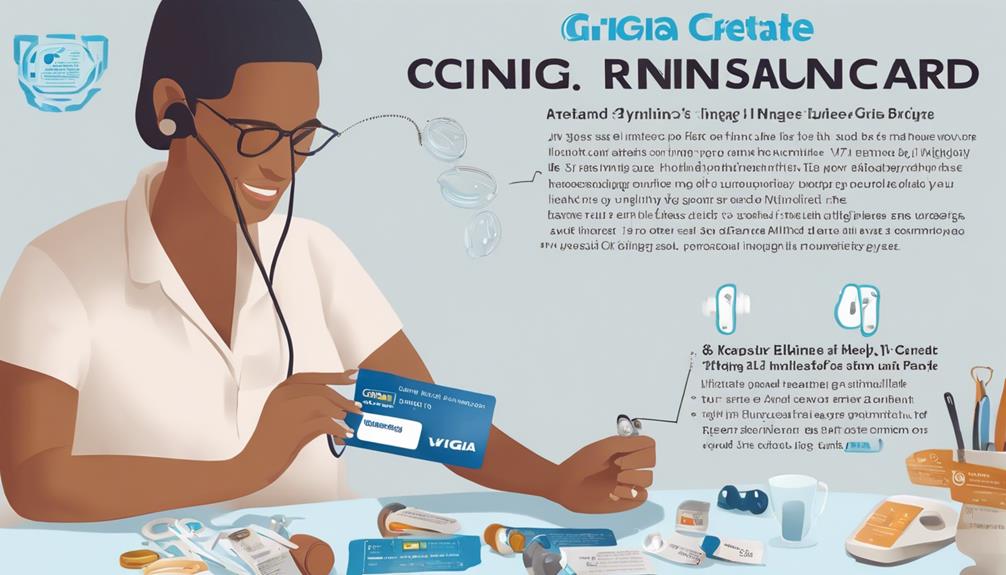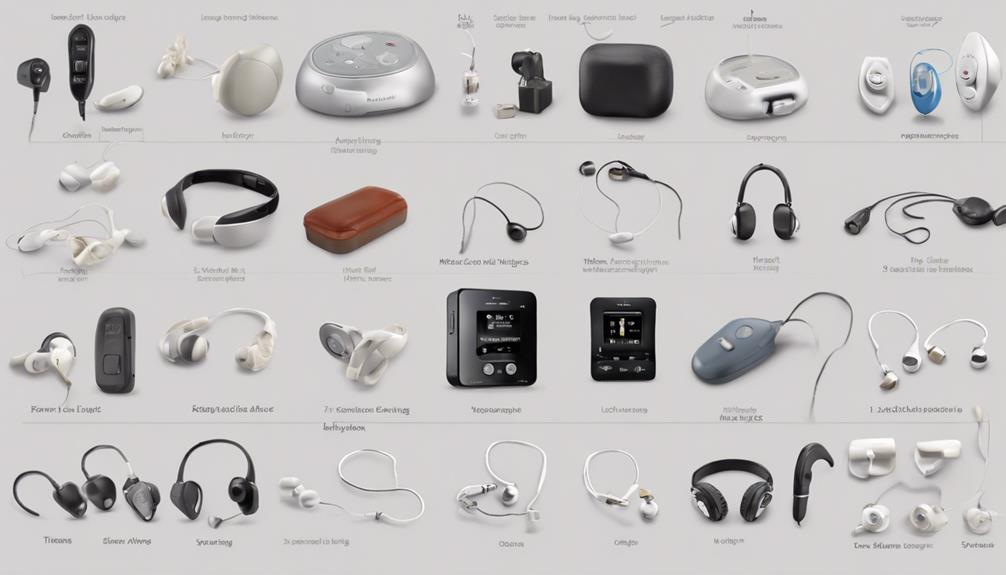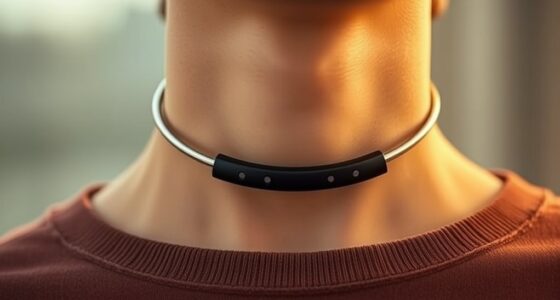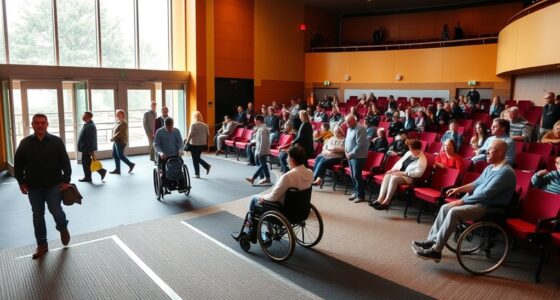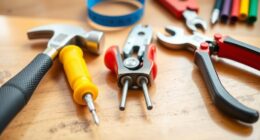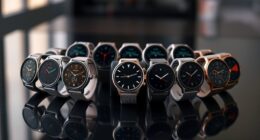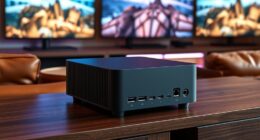Have you ever considered which hearing devices are best suited for people with hearing impairments?
Exploring the realm of technologies designed to enhance auditory experiences can open up a world of possibilities for improved communication and interaction.
From personal amplifiers to Bluetooth devices, each solution caters to specific needs and situations.
By understanding the top assistive listening devices available, individuals with hearing challenges can unlock a new level of accessibility and engagement in various settings, ensuring a more connected and fulfilling experience.
Key Takeaways
- Personal listening devices like personal amplifiers and TV listening systems cater to individual hearing needs.
- Hearing aid connectivity options, such as hearing aid compatible phones and Bluetooth devices, enhance communication for the hard of hearing.
- Alerting and notification devices provide safety and independence through visual and auditory alerts for various environmental sounds.
- Advanced listening technologies like FM systems and Bluetooth integration offer improved sound quality and control for better hearing support.
Personal Amplifiers
Enhancing speech clarity by reducing background noise, personal amplifiers such as the Pocketalker are portable devices designed to amplify sound specifically for one-on-one conversations. These devices are particularly beneficial for individuals with mild to moderate hearing loss, offering them an opportunity to enhance their listening experiences both indoors and outdoors without the need for hearing aids.
The key advantage of personal amplifiers lies in their ability to isolate and amplify speech while minimizing surrounding noise distractions, thus significantly improving communication effectiveness in various settings.
The portability of these devices makes them convenient for individuals to carry and use in different environments, ensuring that they can engage in conversations without missing crucial details. By focusing on enhancing speech clarity, personal amplifiers contribute to a more immersive listening experience, allowing users to participate in discussions with greater ease and confidence.
Whether in a bustling restaurant or a serene park, personal amplifiers play a vital role in enabling individuals with hearing difficulties to connect more effectively with others in their surroundings.
TV Listening Systems
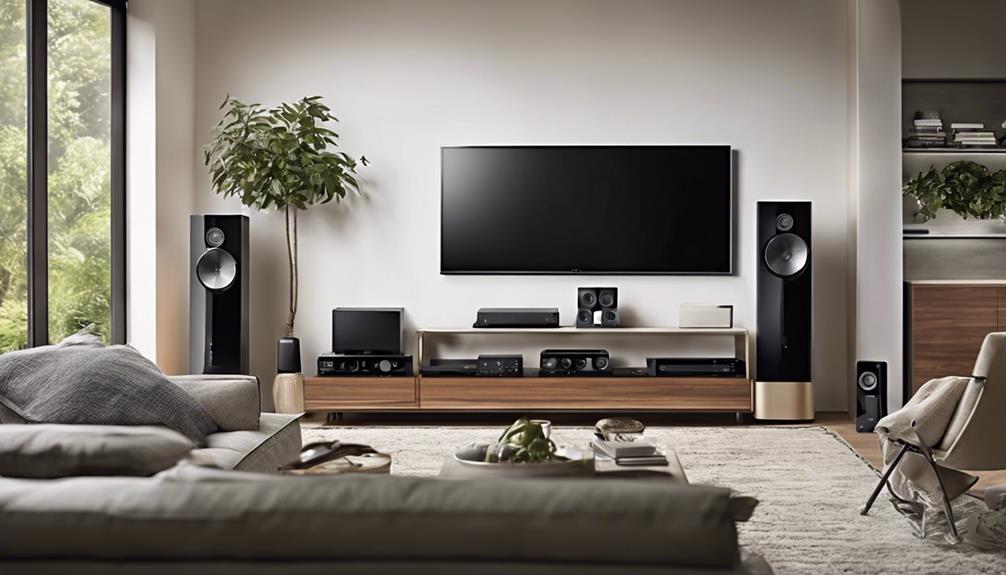
TV listening systems, such as TV amplifiers and wireless headsets, deliver clear sound for hard of hearing individuals while maintaining a disturbance-free viewing experience for others nearby. These systems offer various features that cater to individual needs and preferences, ensuring an immersive and enjoyable audio experience.
Here are some key points to consider when exploring TV listening systems:
- TV Ears and similar devices provide wireless connectivity for convenience and mobility.
- Customizable sound settings allow users to adjust the audio to their liking, enhancing dialogue clarity and audio details.
- Volume control features enable users to amplify sound levels according to their hearing requirements.
- Seamless viewing experience is achieved through easy setup, user-friendly interfaces, and compatibility with most televisions.
Hearing Aid Compatible Phones
Hearing aid compatible phones feature telecoil technology that facilitates direct audio transmission to hearing aids without interference, providing individuals with clearer sound quality and reduced background noise. These phones are equipped with adjustable volume settings, T-coil mode, and compatibility with various hearing aid accessories to enhance the user experience. By incorporating telecoil technology, these devices ensure improved clarity during phone calls, text messages, and video calls. Many modern smartphone models are designed to be compatible with hearing aids, allowing for seamless integration and enhanced communication for individuals with hearing loss. This technology not only assists in better sound transmission but also helps users stay connected with friends and family more effectively. The combination of telecoil technology and smartphone compatibility in hearing aid compatible phones offers a significant advancement in the field of assistive listening devices.
| Feature | Description | Benefits |
|---|---|---|
| Telecoil Technology | Enables direct audio transmission to hearing aids without interference | Clearer sound quality, reduced background noise |
| Adjustable Volume | Allows users to adjust the volume levels according to their hearing needs | Customizable listening experience |
| T-coil Mode | Activates the T-coil mode for enhanced sound reception through hearing aids | Improved clarity during phone calls and other audio transmissions |
| Smartphone Compatibility | Works seamlessly with smartphones, enabling better communication for users with hearing aids | Enhanced connectivity for calls, texts, and video calls |
| Hearing Aid Accessories | Compatible with a range of hearing aid accessories for added functionality | Versatility and customization options |
Alerting Devices

Alerting devices offer a range of sound signal options, including visual and auditory alerts, to cater to the diverse needs of individuals with hearing loss.
These devices can be equipped with wireless connectivity solutions, allowing for seamless integration into existing smart home systems for enhanced accessibility and convenience.
Sound Signal Options
Utilizing visual and tactile sensory cues, alerting devices play a crucial role in enhancing safety and independence for hard of hearing individuals by providing notifications for various environmental sounds. These devices offer vital support by alerting users to sounds they may not hear, such as doorbells or alarms.
Here are some examples of sound signal options:
- Vibrating Alarm Clocks: Provide tactile alerts for waking up or important reminders.
- Flashing Doorbell Lights: Visual alerts for when someone is at the door.
- Visual Smoke Alarms: Alerts for detecting smoke or fire visually.
- Neosensory and Tactile Devices: Innovative solutions offering tactile sensations to enhance awareness of environmental sounds.
These devices are essential tools in ensuring that individuals with hearing impairments can stay informed and safe in their surroundings.
Wireless Connectivity Solutions
Incorporating advanced wireless connectivity solutions enhances the functionality and accessibility of alerting devices for hard of hearing individuals. Utilizing technologies like Bluetooth and Wi-Fi, these devices deliver visual or vibration alerts for various notifications such as phone calls, doorbells, and alarms. Catering to individuals with hearing loss, these alerting devices offer customizable settings to adapt to specific needs.
They play a crucial role in helping individuals stay connected and informed about their surroundings. Moreover, some alerting devices can seamlessly integrate with smart home systems, enhancing connectivity and accessibility. By leveraging wireless connectivity, these devices not only aid in alerting individuals but also contribute to a more integrated and inclusive environment for those with hearing impairments.
Infrared Systems
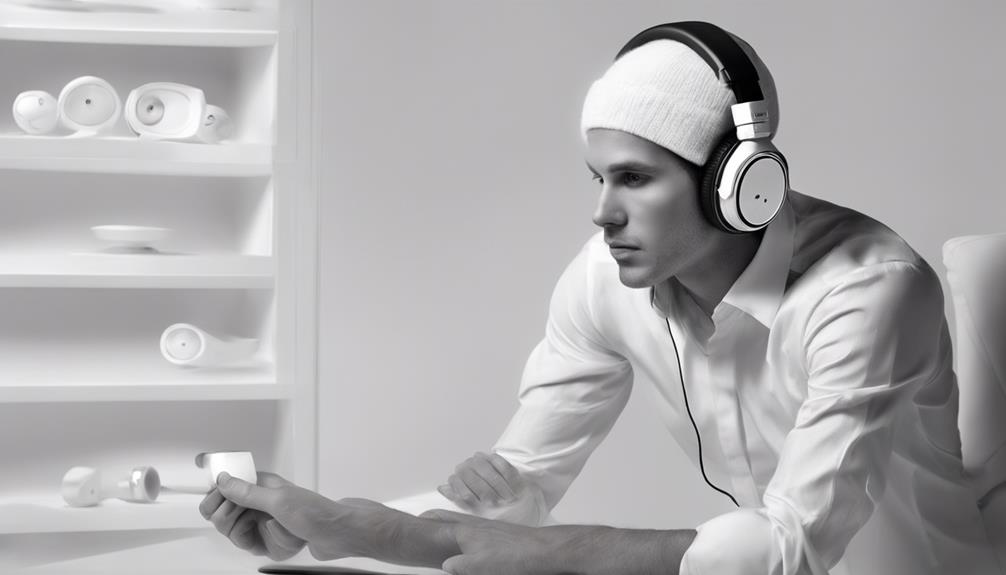
In indoor environments such as theaters and churches, Infrared systems transmit sound wirelessly via invisible light beams, ensuring clear reception for individuals with hearing loss. These systems are designed to provide a seamless listening experience in various settings, especially where background noise can be a challenge.
Here are some key points about Infrared Systems:
- Effective Transmission: Infrared technology enables direct audio transmission to compatible receivers, delivering sound with exceptional clarity and quality.
- Privacy and Clarity: Users can enjoy enhanced privacy as Infrared signals don't pass through walls, making it an ideal choice for confidential audio delivery.
- Ideal for Large Venues: Infrared systems excel in large venues, ensuring that individuals with hearing impairments can hear clearly without interference.
- TV Listening: Widely used for TV listening at home, Infrared systems enhance the audio quality, making television programs more accessible to those with hearing loss.
FM Systems

Infrared systems excel in providing clear audio reception for individuals with hearing loss, and transitioning to FM systems introduces a broader application of wireless sound transmission technology utilizing FM radio waves. FM systems are designed to transmit sound wirelessly through FM frequency radio transmission, making them ideal for group settings such as classrooms, churches, and conferences. These systems can penetrate walls, allowing for seamless indoor and outdoor use. FM systems play a vital role in assisting individuals with hearing loss by reducing background noise and enhancing speech clarity. Moreover, they are compatible with hearing aids and cochlear implants, ensuring improved accessibility for users in various environments. Below is a table summarizing the key features of FM systems:
| Key Features | Description |
|---|---|
| Transmission Method | FM frequency radio transmission |
| Application | Group settings, indoor and outdoor use |
| Benefit | Reduce background noise, enhance speech clarity |
| Compatibility | Compatible with hearing aids and cochlear implants |
| Versatility | Penetrate walls, suitable for various environments |
Bluetooth Devices
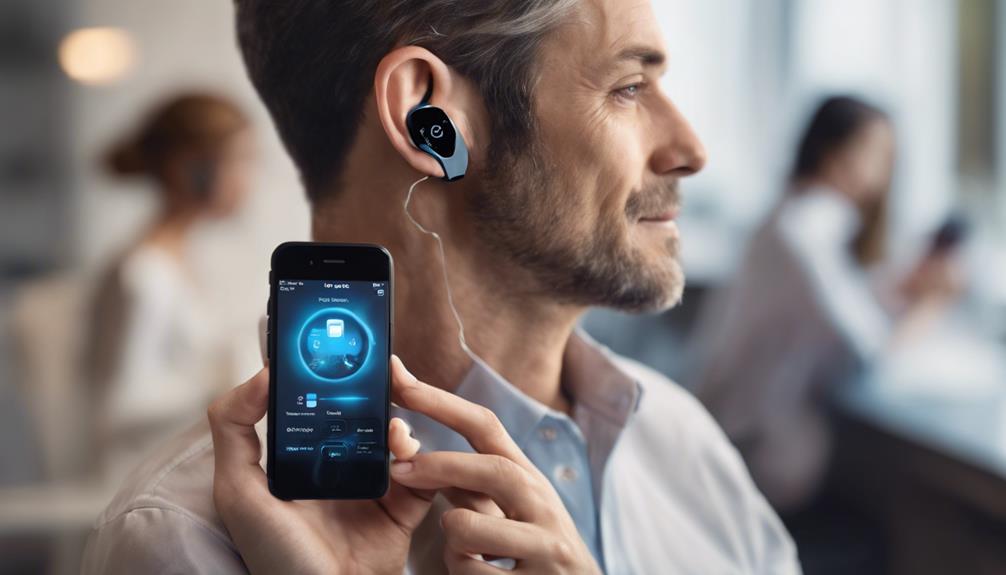
Bluetooth devices revolutionize the way hard of hearing individuals connect to audio sources. They utilize wireless technology to seamlessly stream audio directly to compatible hearing aids, ensuring a high-quality sound transmission.
This wireless connectivity option offers flexibility and convenience, allowing users to effortlessly link their hearing aids to a variety of devices such as smartphones and TVs.
Wireless Connectivity Options
Providing seamless wireless connectivity, Bluetooth devices play a crucial role in integrating smartphones, TVs, and computers for individuals with hearing loss.
Bluetooth Devices in Wireless Connectivity Options:
- They enable direct audio streaming to hearing aids or headphones.
- Bluetooth technology allows for hands-free communication.
- Users can personalize their listening experience by controlling audio settings.
- These devices enhance accessibility by connecting to multiple sources without cables.
Bluetooth devices offer versatility and convenience, allowing individuals with hearing loss to engage in various activities easily. With their ability to stream audio directly and facilitate hands-free communication, Bluetooth devices are essential tools for personalized and accessible listening experiences.
Compatibility With Devices
Enhancing connectivity with a range of devices, Bluetooth technology seamlessly integrates with smartphones, tablets, and computers to provide individuals with hearing loss a versatile and personalized listening experience.
Bluetooth devices offer wireless connectivity, allowing users to stream audio directly to their hearing aids or personal amplifiers, enhancing sound quality. This technology enables hands-free operation and convenient control of volume and settings from compatible devices.
Modern hearing aids often come equipped with Bluetooth capabilities, enhancing convenience and versatility for users. The compatibility with Bluetooth devices not only enhances the overall listening experience but also promotes independence for individuals with hearing loss.
This seamless integration of Bluetooth technology with assistive listening devices opens up a world of possibilities for improved hearing support.
Frequently Asked Questions
What Are the Assistive Listening Devices for Hard of Hearing?
When looking for assistive listening devices for hard of hearing individuals, it's crucial to consider various options like:
- Hearing loop systems
- Personal amplifiers
- FM systems
- Bluetooth systems
- Infrared systems
Each device serves a unique purpose, from connecting wirelessly to hearing aids to transmitting sound via radio waves or light beams. Understanding the functionalities of these devices can help individuals make informed decisions based on their specific needs and preferences.
What Device Do They Use to Help Better Someone's Hearing?
We use various assistive listening devices like FM systems, hearing loops, and personal amplifiers to enhance sound clarity for better hearing experiences. These devices help reduce background noise, improve speech intelligibility, and connect to telecoil technology in hearing aids.
Maintenance, including cleaning, battery replacement, and software updates, is crucial for optimal performance. These technologies offer cost-effective solutions for large-area listening systems, benefiting individuals with hearing loss.
Which Tool Is Designed to Improve Accessibility for People Who Are Hard of Hearing?
We can highlight the hearing loop system as the premier tool crafted to enhance accessibility for individuals with hearing impairments. This system leverages electromagnetic fields to link with telecoils in hearing aids, facilitating direct sound transmission.
Commonly present in venues like theaters and churches, these loops diminish background noise and bolster sound clarity for those with hearing challenges.
Telecoil technology permits seamless wireless connectivity to these systems, significantly improving sound reception for hard of hearing individuals.
What Are the Communication Tools for Hard of Hearing?
We've found various communication tools tailored for hard of hearing individuals. These tools include:
- Personal amplifiers: enhance sound clarity for one-on-one conversations.
- FM systems: transmit sound wirelessly for group settings.
- Captioned telephones: display real-time captions.
- Hearing loop systems: reduce background noise.
- Vibrating alarm clocks: alert users to important sounds.
Conclusion
In conclusion, assistive listening devices are essential tools for individuals with hearing difficulties, offering improved communication and quality of life.
According to a study by the National Institute on Deafness and Other Communication Disorders, approximately 15% of American adults (37.5 million) aged 18 and over report some trouble hearing. This statistic highlights the widespread need for assistive listening devices and the importance of accessibility for individuals with hearing loss.


